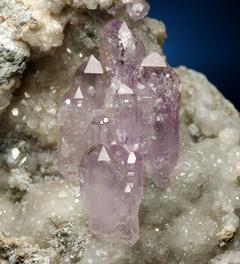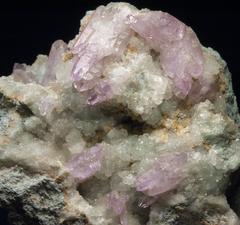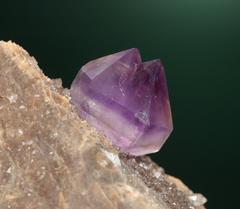last modified: Sunday, 13-Nov-2011 20:43:46 CET
Document status: complete

|
The name refers to its alleged ability to protect its owner from the negative effects of alcohol consumption, namely "methy", the Greek expression for being drunk, and "a-methy-stos" would translate to "one that does not get drunk"[1]. This association probably came up because of the color of red wine is sometimes similar to that of amethyst.
Specific Properties
Amethyst is a very special quartz. Although it occurs in many different rocks in many different forms, most amethysts share certain basic properties, not just the color.The color can vary from a pale pinkish violet to a dark blue-violet, with shades of red, and sometimes gray. Very often the color is unevenly distributed or even patchy, and is most intense at the tips of the crystals. Amethyst shows a weak dichroism, with the color changing from gray-violet to purple.
Amethyst owes its color to high energy radiation, e.g. gamma rays from radioactive sources (Berthelot, 1906) and the presence of iron built into its crystal lattice (Holden, 1925). The irradiation causes iron Fe(+3) atoms which probably replace the silicon in the center of the SiO4 tetrahedra to lose another electron and form Fe(+4), an unusual oxidation state of iron (Lehmann and Moore, 1966). Note that the colorizing iron and its precursor is probably not present in the lattice as ideal ions (Fe3+ and Fe4+), but in part bound covalently to oxygen to form a FeO4 group. The electron released from the iron by irradiation is probably taken up by another ion, but there are different models on how exactly the Fe(+4) color center is stabilized. According to a theory of Lehmann et. al., 1973, the electron released from the Fe3+ to form Fe4+ is captured by another Fe3+ elsewhere in the lattice which gets reduced to a Fe2+, so the color center would be a pair of [FeO4]2+/Fe2+ formed in this reaction:
However, other mechanisms including the role of other ions in the charge compensation have been proposed and the details of the nature and formation of amethyst color centers are still a matter of debate. For a review of the different recent theories, see Rossman, 1994, early theories have been discussed by Holden, 1925.
Note: Do not expose an amethyst to direct sunlight for a long time. Very likely it will pale out by the ultraviolet radiation. Some amethyst pales out really quickly and some very slowly, but you can't tell in advance. Even the intense sunlight behind the window in your living room might do some damage, although the ultraviolet components are mostly filtered out by the window glass. This is actually true for all quartz varieties whose color is irradiation-induced (smoky quartz, citrine, pink quartz). In the summer I often cover my showcases with a black cloth.
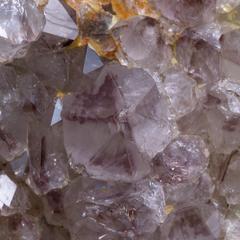
5mm 800x800 105kb
|
Sometimes the color is concentrated in zones parallel to crystal faces, giving them a phantom-like appearance. This is due to changes in environmental conditions during growth, namely fluctuations of the iron content and temperature of the solutions the crystals grew in. The picture to the right is a detailed view of crystals from Amatitlan, Guerrero, Mexico, showing multiple "phantoms". You can see that both crystals show a similar color pattern: going down from the tip the distance between the 5 main color patches is "short - long - very short - long". So the pattern reflects environmental changes acting on both crystals simultaneously.
In addition, the left crystal has a diamond shaped negative crystal (a bubble formed like a crystal) with its borders parallel to the color zones. You can see another bubble of similar shape at the right crystal, although a bit out of focus. Both are placed at the same position relative to the color pattern and this might be another effect of changing environmental conditions during growth.
Amethyst can occur in various crystal habits and growth patterns. Some of them seem to be typical for amethyst: Amethyst from druses in volcanic rocks is short-prismatic, the prism faces often do not develop at all. At many locations in igneous and highly metamorphosed rocks (e.g. in the Alps), amethyst grows as scepters on top of rock crystals or smoky quartz. While there are nice examples of relatively elongated amethyst crystals, I've so far not seen or heard of amethyst that formed as needle quartz. Needle quartz grows quickly and that might either inhibit the correct incorporation of iron into the crystal lattice or lead to an inclusion of impurities that suppress the formation of color centers.
As the color of amethyst is caused by iron-based color centers, iron minerals are often companions of amethyst. Of those two, goethite (FeOOH) and hematite (Fe2O3) frequently occur as inclusions.
The crystal form of amethyst (determined by the types of crystal faces that appear on a crystal) is usually rather "boring": you will probably never find any accessorial crystal faces on it. Amethyst crystals are usually simply made up of the prism and the rhombohedra. Especially in amethyst from geodes in volcanic rocks the r-rhombohedron is very prominent, giving the crystals a trigonal appearance.
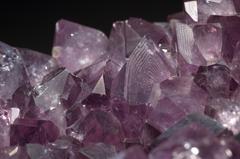
0mm 1519x1006 195kb |
You can visualize the structure on thin slabs of amethyst with polarized light, or you can etch out the pattern on the rhombohedral faces using hydrogen fluoride[2]. Sometimes you can see that pattern directly on crystal faces, as in the detailed view of an amethyst from Uruguay to the right. Note that the "fingerprint" is visible only on the larger r faces, and not on the z faces. Some authors have even suggested to name any quartz with such a twinning pattern amethyst, no matter what its color might be.
So we might speculate that either
- the traces of iron in amethyst have a much greater influence on growth and crystal structure than the traces of aluminum have in smoky quartz, which does not suffer any restrictions in terms of crystal habit, form, and twinning,
- or the environmental conditions that allow iron to be built into the crystal lattice also lead to a specific twinning pattern and also do not allow accessorial crystal faces to form.
Currently I would favor the second explanation. Artificially grown amethyst does not show a polysynthetical twinning, unless it is grown on top of an accordingly twinned crystal. And there are amethysts which do show accessorial faces, lack polysynthetical Brazil law twinning and even seem to be untwinned altogether in some cases. So the presence of iron alone does not suffice for the twinning to occur.

10mm 1800x1568 317kb - 3600x3136 889kb |
The Namibian locations appear to be the only places where amethyst with accessorial faces is found frequently. Rykart reported a single find of amethyst showing s-faces at the Ahrntal, Southern Tyrol, Italy (Rykart, 1995). Mexican amethyst from the Las Vigas area very rarely shows flat rhombohedral faces that separate r- and z-faces (Lieber and Frenzel, 1990).
Occurrence
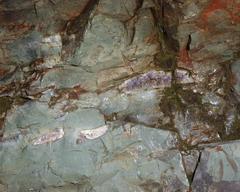
1200x960 234kb - 2400x1920 729kb |
Amethyst is also found in igneous, and certain metamorphic rocks, as those contain enough radioactive trace elements for a sufficient irradiation of the crystals. Amethyst from sedimentary rocks is very rare, and the crystals are usually very pale in color. As the ubiquitous iron is built into the crystal lattice, amethyst is sometimes found in ore deposits. However, to be built into the quartz crystal lattice, the iron needs to be present as Fe3+, and not as Fe2+. Amethyst can probably not form in watery solutions that contain a large amount of reducing agents, like H2S or methane, CH4, as these would either stabilize Fe2+ or reduce Fe3+ to Fe2+. Oxygen present in the watery solution will cause the formation of Fe3+. For example, in many ore deposits the minerals in the part that came under the influence of meteoric waters have been altered and oxidized, and because of its rusty overall appearance, this part is called an iron gossan. One might speculate that amethyst scepters that seem to form at a later stage and lower temperatures (which translates into "nearer to the surface") than the underlying crystal also formed under the influence of oxidizing meteoric waters.
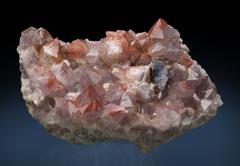
50mm 2376x1640 518kb - 4752x3280 1707kb |
Locations and Specimen
Amethyst is found at many places all over the world. Today the economically most important producers of gem amethyst are Brazil and Uruguay. Amethyst is also commercially mined in Canada, Pakistan, Madagascar, or Finland, just to name a few countries.You'd be surprised to see how difficult it is to get a hold of an amethyst from the European Alps. Here amethyst occurs only at a few spots, mostly as scepters grown on rock crystals, or as scepter- and skeleton quartz aggregates.
Afghanistan

10mm 1024x826 107kb - 2494x2012 500kb |
Austria
The most famous amethyst localities in Austria are in the Zillertal Alps, a mountain chain bordering Italy at the southern end of the Zillertal valley in Tyrol. Amethyst from this location once used to be cut for jewelery, but now the prices for good Zillertal specimen by far surpass the value of even an excellent cut stone from Uruguay.Alpine amethyst seems to have been formed mainly as scepters as a second generation on older quartz crystals. They grew probably in a cooler solution than the old crystals. Amethyst from Alpine locations is said to pale more quickly in sunlight.

10mm 777x979 94kb - 1554x1958 301kb |

approx. 50mm 1024x1024 134kb - 2004x2004 416kb |

10mm 1066x1007 141kb - 2132x2014 431kb |
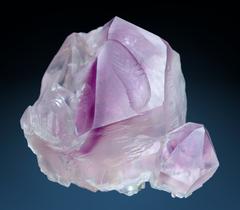
10mm 1200x1048 120kb - 2400x2096 384kb |
Brazil
Immigrants from the Idar-Oberstein area in Germany were the first to systematically exploit the agate and amethyst deposits in Brazil and Uruguay in the early and mid 19th century. Most amethyst comes from Rio Grande do Sul, where it is found as crystals outlining gas cavities in basalt, forming nice and sometimes quite large druses.

approx. 1 m 1296x978 386kb |
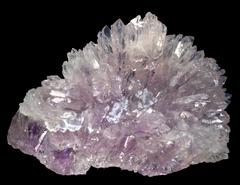
20mm 1245x960 203kb - 2490x1920 626kb |

20mm 910x1006 195kb - 1820x2012 650kb |

50mm 1422x1006 217kb - 2844x2012 685kb
|
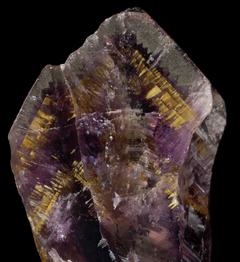
10mm 864x944 154kb - 1728x1888 521kb |
Canada
One of the few areas in western countries where amethyst is commercially mined is the Thunder Bay area at Lake Superior in Ontario, Canada. However important this location may be, very few specimen have made it to fairs on this side of the Atlantic, so I have to apologize for the lack of images and can only point you at related web sites:
in particular: Ontario Amethyst - Geology of Amethyst in the Thunder Bay area

10mm 1200x1000 189kb - 2400x2000 598kb |
Finland
There is an amethyst mine in northern Finland, running its own web page in Finish, English and German: www.amethystmine.fi.
Germany
The Idar-Oberstein area used to be a major source of gem quality amethyst until German emigrants started to exploit South American sources in the 19th century. Today, there is no commercial mining of amethyst or agate in Germany, just a few fee-collecting sites where rockhounds can try their luck.The Juchem quarry at Niederwörresbach north of Idar-Oberstein is probably the best-known fee-collecting site in Germany. It is mined for volcanic rocks (andesite, dacite, basalt), but on the weekends rockhounds are allowed in. One can find agate, amethyst, calcite, and smoky quartz, but the prospect depends on the actual mining situation in the quarry, and good quality amethyst is rare. Nevertheless, the quarry attracts rockhounds from quite a distance, even from the Netherlands. Should you plan to go there, I would recommend to bring heavy tools, including a medium sized sledge hammer, and to lower your expectations.

20mm 1200x988 151kb - 2400x1976 461kb |

20mm 1305x869 168kb - 2610x1738 542kb |
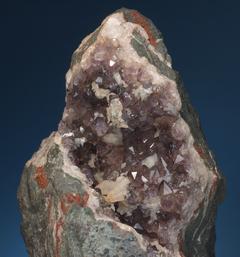
10mm 942x1007 156kb - 1884x2014 495kb |
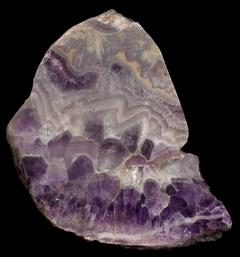
20mm 1024x1096 148kb - 4337x4640 1962kb |
Greece
Greece is more famous for its prase location, Serifos, but one can also find nice amethyst on this island.Recently finds of amethyst and smoky quartz have been reported from the alpine-type fissures at the southern slopes of the Rhodopes mountains in northern Greece, bordering Bulgaria.
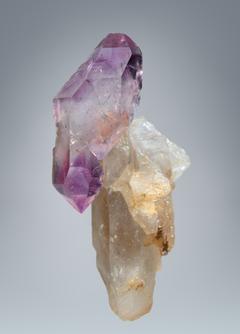
5mm 1000x1392 92kb - 2000x2784 265kb |
The specimen came from an alpine-type cleft near the village of Dasoto in the Kato Nevrokopi Basin, Drama, Northern Greece. Donated by Anastasios Tsinidis.

5mm 964x1000 86kb - 1928x2000 252kb |
Hungary

20mm 2272x1440 360kb |
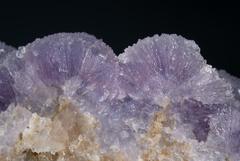
10mm 2128x1424 457kb |
Italy
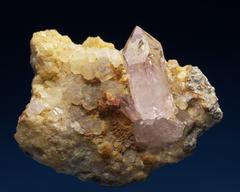
10mm 1024x821 96kb - 2425x1944 408kb
|
Osilo amethyst appears as small (usually well below 5 cm), prismatic crystals of various habits. Individual Crystals are common, groups of parallel intergrown crystals can also be found.
The crystals are very evenly colored, although usually not very deeply. Many crystals are clear and transparent, but I've also found some odd-shaped translucent crystals. If the color was more intense, one could - at a first glimpse - mistake the specimen for Las Vigas amethyst, as in both cases the prismatic crystals sit on a greenish matrix rock.
Crystals can be hexagonal prisms with both r and z rhombohedral faces, or trigonal "Muzo-like", with distorted prisms and only r faces present. Many crystals show signs of fenestration or "skeletized" rhombohedral faces. Even more interesting are some odd-shaped "telescope" scepters (inverted scepters, with the next generation of crystals being more narrow than the preceding one).
The first image shows a small, evenly colored skeleton amethyst on a calcite and siderite matrix.
A nice group of parallely grown amethyst crystals can be seen in the next picture. The matrix is covered by pale gray-green calcite, and some of the crystals are found on the amethyst crystals. These crystals are unusually large for Osilo.
Below a few groups of parallel-grown amethysts with reversed scepter habits, again surrounded by calcite crystals.
The last image shows single reverse scepter crystals that are partially covered by brown calcite crystals and some siderite.
Kazakhstan
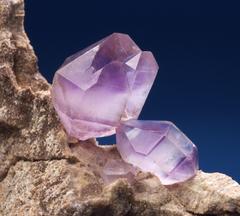
10mm 1024x923 115kb - 2232x2012 408kb |
Madagascar
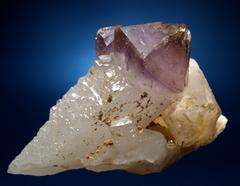
10mm 1224x950 137kb - 2448x1900 411kb |
The specimen to the right is from Andilamena, north of Lac Alaotra. The scepter itself only shows very small m-faces (leading to a short-prismatic habit) and the former prism-faces (or m-faces) of the first generation crystal are covered by small white crystals of similar habit that are oriented parallel to the scepter.

10mm 1007x1456 128kb - 2014x2912 396kb |
Mexico
Some of the nicest amethyst comes from Mexico. Two spots are really famous: Amatitlan, Guerrero, and Las Vigas, Veracruz. Mexico's amethysts are rarely used for jewelery, though, because deeply colored crystals suited for lapidary work are much too rare. Amethysts are nevertheless mined by the local population and sold as specimen to collectors and traders.The mountain village Las Vigas (now officially called "Profesor Rafael Ramirez") lies 200 km east of Mexico City in the province of Veracruz. The exact location is about 15 km north of Las Vigas near the village Piedra Parada. The first detailed description of the location and its petrology came from ->Lieber and Frenzel. The amethyst crystals grew in pockets in an volcanic rock of andesitic composition. The rock contains many small gas cavities, but the amethyst grew in clefts and vugs, sometimes along quartz veins, and not in geodes, as most amethyst from volcanic rocks do.

20mm 1332x1006 185kb - 2664x2012 516kb |

20mm 1483x1006 199kb - 2966x2012 642kb |
The second famous amethyst locality in Mexico is the village of Amatitlan in the State of Guerrero. A good description of the locality has been written by ->Ontiveros, Wilson and Megaw. The amethyst crystals come from pockets in skarn deposits that formed during the intrusion of a granitic magma into dolomitic limestones and shales. Amethyst of similar shape comes from skarn rocks on the island of Serifos, Greece, and from veins in volcanic intrusions in limestones at the village of Porkura in Romania (->Stöhr), but these locations have produced a much smaller number of specimen.

10mm 800x1000 89kb - 1600x2000 295kb |
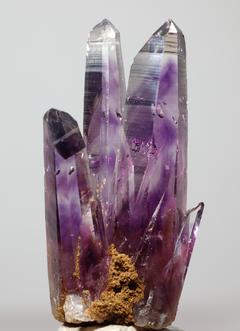
10mm 687x948 77kb - 1374x1896 239kb |
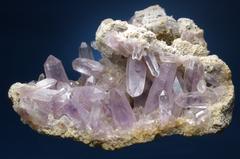
20mm 1519x1006 247kb - 3038x2012 790kb |

20mm 1086x974 214kb - 2172x1948 657kb |
The geodes will contain colorless quartz, smoky quartz, agate, calcite or amethyst. A distinguishing feature of the geodes is an outer layer of dark brown calcite and a bright, almost powdery coating of weathered volcanic tuff. The specimen to the right is a medium-sized geode that has an outer shell of brown calcite, followed by layers of bluish chalcedony and colorless quartz with violet tips.
Namibia

10mm 714x1007 100kb - |
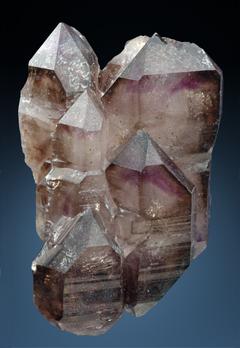
10mm 1048x1520 236kb - 2096x3040 681kb |
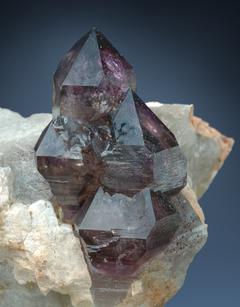
10mm 1000x1280 185kb - 2000x2560 566kb |

5mm 1424x1920 356kb |
There is a nice gallery of Namibian amethysts and quartzes at http://www.mb-minerals.de/.
Nigeria
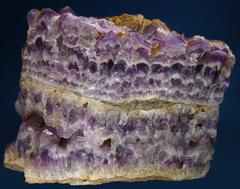
20mm 1024x805 180kb - 2424x1905 750kb |
Norway

10mm 1034x1004 118kb - 2068x2008 367kb |
The image shows short-prismatic crystals associated with dolomite and pyrite from Stange, Hedmark, east of Lake Mjøsa in Southern Norway.

5mm 1120x928 111kb - 2240x1856 304kb |
If you want to see more, you should have a look at Kai Helge Andersen's mineralcollector page, who has quite a few amethysts on display, most of them from Norway.
Pakistan

10mm 1024x826 123kb - 2494x2012 366kb |
Russia
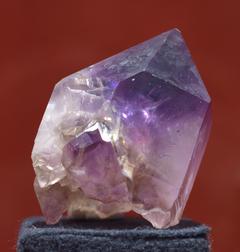
approx. 50mm 975x1024 96kb - |
South Africa
Since a couple of years very nice cactus quartz, also known as spirit quartz, from South Africa is frequently offered on fairs. Most of the crystals still have a first generation tip that has not been encrusted by younger crystals. There are white, yellow, and smoky crystals, but pale amethyst seems to be most common. Intensely violet crystals are the most wanted and are more and more difficult to get.There has been some confusion about the exact location of the specimen. First, "Magaliesberg" was said to be the origin (and there were different interpretations of what "Magaliesberg" actually meant), then, after a few years, the labels on the mineral fairs were changed to say Marble Hall, a small town about 120 km north east of Pretoria. Meanwhile, the location has been corrected again, and is now said to be the area around the former Boutenhouthoek and Mathys Zyn Loop farms, about 45 km south west of Marble Hall, or 80 km north east of Pretoria (Sprich et al., 2003; Cairncross et al., 2004).
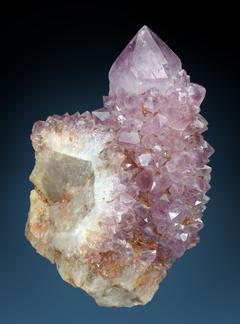
10mm 1024x1384 173kb - 2048x2768 491kb |
The first image shows a dark colored specimen with one crystal broken off, so the six-sided prism of the first-generation crystal can be seen underneath the smaller amethyst crystals.
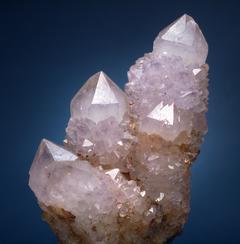
20mm 990x1006 121kb - 1980x2012 437kb |
Sweden
Ransäter, Värmland
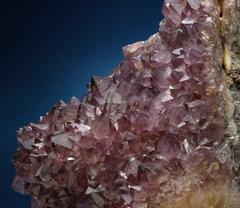
20mm 1164x1007 193kb |
Tanzania
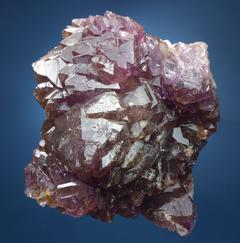
20mm 987x1000 205kb - 1974x2000 684kb |
Uruguay
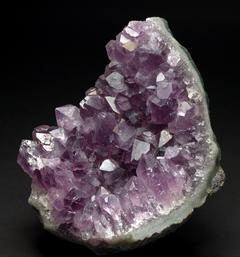
20mm 939x1006 149kb - 1878x2012 469kb |
USA
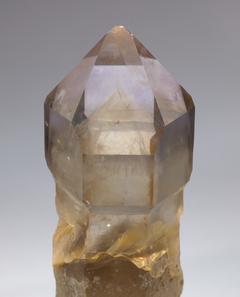
10mm 800x990 57kb - 1600x1980 179kb
|
More images of the deeper colored amethyst scepters from that location can be seen on Kai Helge Andersen's mineralcollector page.

20mm 1422x1006 272kb - 2844x2011 819kb |
The first image shows dark and evenly colored amethysts in a small pocket. The pocket was associated with a quartz vein.
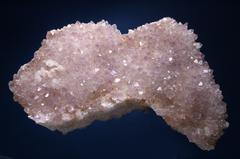
20mm 1519x1006 210kb - 3038x2012 696kb |

10mm 918x1004 132kb |

20mm 2048x1424 581kb - 4096x2848 1712kb |

20mm 1080x1006 185kb - 2160x2012 563kb |
Further Information, Literature, Links
Werner Lieber has written a nice ->book about amethyst, albeit in German. It covers not only the mineralogical aspects, but also the history of amethyst "mining" and includes many pictures of specimen from locations all over the world.
Footnotes
1 Thanks to Anastasios Tsinidis for helping me on this.2 That′s why it is a bad idea to clean amethyst specimen in an ultrasonic bath. The crystals might part along the twinning planes.
3
Some of you might find it tempting to do some experiments with hydrogen fluoride. Hydrogen fluoride is a very dangerous substance. Just look up a case in a good textbook on toxicology; after the lecture you will not want to touch it even with a pole. The watery solution is not a strong acid (pure HF is), and the undissociated small HF molecules easily penetrate the skin and bind calcium in the cells to form insoluble fluorite, CaF2. Calcium is essential for the live functions of all body cells. A small drop on a finger that goes unnoticed as it does not immediately hurt can - after some delay - cause substantial damage and great pain.
Let′s quickly do the math: 1 Mol HF = 20g. A drop (approximately 50 μl) of a 20% solution contains 0.00005 l x (200g/l) = 0.01 g. 10 mg, that doesn′t sound like much.
1 Mol Ca = 40g and 1 Mol F = 19g. 1 Ca will bind 2 F, thus 40g Ca will bind 38g F from 40g HF. 1 ml of you body tissue contains about 0.1mg Ca, and 0.1mg HF will let it precipitate almost completely. In theory, the 10mg HF in the small drop could precipitate most of the Ca in 100 ml tissue, killing all cells in it.
And no, I am not opposed to water fluoridation (no irony here).
4 Which is not to say that collecting is permitted. I′ve heard contradictory reports about the collecting situation, and my own experiences are mixed as well: one time no one seemed to care, the next time I was not allowed in.
 Printer Friendly Version
Printer Friendly VersionCopyright © 2005-2013, A.C. A k h a v a n
Impressum - Source: http://www.quartzpage.de/amethyst.html



